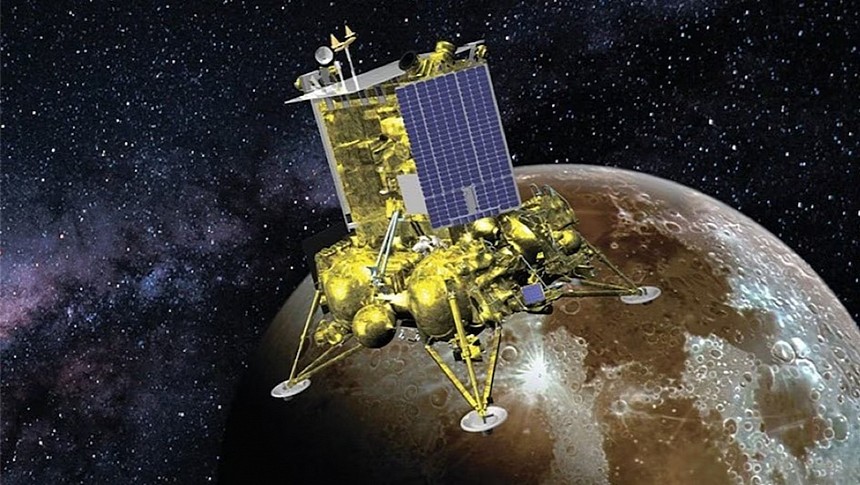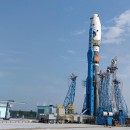Russia's first crack at sending an un-crewed lander probe to the surface of Earth's nearest heavenly neighbor in decades was supposed to send a message from the government of Vladimir Putin to the world at large. This message was that despite seemingly endless sanctions from Russia's illegal occupation of Ukraine, Roscosmos could still compete with Western space agencies in meaningful scientific research. But after the Luna 25 lander unceremoniously crashed into the surface of the Moon, the only sentiment for the Russian Space program was abject disappointment.
But the saga of what took place between the Soviet Union's previous un-crewed Moon lander mission and its successor state's follow-up in 2023 is a curious lens through which to view all the problems with modern Russia. It's a lens that, admittedly, might not be as on-the-nose as the war in Ukraine. But it's one with a historically significant backstory even so.
The roughly 30-kg (66-lb), four-legged lander probe was built by the historic NPO Lavochkin group known best in the Western world for its La-series of piston and jet fighter planes like the La-7, La-9, La-11, and the La-15. The firm also designed and manufactured the S-75 Dvina surface-to-air missile system credited for shooting down an American U-2 spy plane during an infamous incident in 1960. They were also responsible for manufacturing the Moon rovers associated with the Lunokhod program, the first of its kind to send remote-controlled robotic vehicles to the surface of another heavenly body starting in the early 1970s.
With this in mind, Luna-25 had some serious industry horsepower behind its construction. Launched from the Vostochny Cosmodrome in Southeastern Russia aboard a Soyuz 2.1b rocket on Aug. 11, 2023, the Luna 25 was the first attempt by a post-Soviet Russian state to land a probe on the surface of the Moon in 47 years. After inserting itself into an orbit around the Moon on Aug. 16, the Luna 25 probe began scouting for a landing sight in the vicinity of the Boguslawsky crater in the Lunar Southern Hemisphere. If successful, Roscosmos intended the probe to collect soil samples and conduct scientific analysis of its immediate surroundings with as many as eight separate scientific instruments for up to one Earth year.
But as the probe was preparing for a pre-landing orbit descent maneuver to put the spacecraft on target for its landing site, an unanticipated anomaly appears to have occurred, most likely a longer-than-anticipated engine burn sending the probe well off course. On August 19th, Roscosmos announced via Telegram that an "emergency situation" had occurred, which "did not allow the maneuver to be performed with the specified parameters," in reference to a planned transfer to a lower pre-landing orbital position. As further information about the particulars of the indecent became available, Roscosmos released further details explaining the nature of what'd just taken place.
“According to the results of the preliminary analysis, due to the deviation of the actual parameters of the impulse from the calculated ones, the device switched to an off-design orbit and ceased to exist as a result of a collision with the lunar surface," as reported by Roscosmos via Russian State Media. In short, the Luna 25 mission had become just another impact crater on the lunar surface. It wouldn't be the first time a Soviet/Russian lunar probe mission ended in this way. On Jul. 21, 1969, one of Luna 25's ancestors, Luna 15, crashed into the Moon roughly 344 miles (554 km) from where Neil Armstrong and Buzz Aldrin were actively scouting the Sea of Tranquility during the Apollo 11 mission. In some respects, the two impacts roughly 54 years apart bear eerily similar qualities.
As it happens, both spacecraft were manufactured by the same Lavochkin design bureau and crashed for ostensibly very similar reasons. Meanwhile, the failure of Luna 25 all but ensures that Russia will lose a little-talked-about space race between itself and India to land an un-crewed lander probe on the surface of the Moon for the first time in their respective nation's current forms. No sooner was the Luna 25 probe reduced to a pile of scrap on the lunar surface did the Indian Space Research Organization (ISRO) post to Twitter that their Moon lander, Chandrayaan-3, was due to take its own shot at a landing on Aug. 23, less than a week after Russia's embarrassing public failure.
Meanwhile, Russian lunar program hardware continues to lag behind that of the United States, which already fields a super-heavy launch vehicle capable of taking humans to the Moon in the SLS rocket and a transit vehicle to get them there in the Lockheed Martin Orion crew capsule. With the Russian economy straining under the weight of total war logistics in Ukraine and the international sanctions that result, the presiding theory is that Roscosmos will need the help of China to continue their ambitions on the Moon, Mars, and beyond, to have any hope of succeeding going forward. For now, the fate of Russia's ambitions in deep space will continue to be sandbagged by the country's ambitions here on Earth, more specifically Ukraine, for the foreseeable future.
But it's precisely for this reason that Luna 25's failure is a microcosm of all the things so desperately wrong about the Russian state as it exists today. Though Luna 25's been in the planning stage in some form since the late 1990s, its launch in 2023 was meant to prove that Russia could still field an effective space agency despite the sanctions brought on by the war in Ukraine. Had it succeeded, the mission would have served just as important of a role in Russian propaganda as it would have conducted science experiments on the lunar soil and exosphere. But instead, Luna 25 only reminded the world at large of Russia's paper tiger status among the world's great superpowers at this juncture.
As the U.S. and China continue to leave Russia in the dust in aerospace technology, perhaps only the cordial relationship between the latter two will ensure Roscosmos still has a place on the world stage in the future. As Russia and China collaborate on more space probes and human-crewed space travel initiatives, don't be surprised if Roscosmos gives the Luna program another shot with China's help sometime soon. For the moment, the follow-up Luna 26 mission flown in tandem with the Chinese Chang'e 7 Lunar Polar Orbiter is set to launch in 2027 at the very earliest. Of course, it's possible that NASA's Artemis program will have already landed human beings back on the Moon for the first time in nearly 60 years by this stage. So to say, it's still evident which proverbial horse leads this new space race.
The roughly 30-kg (66-lb), four-legged lander probe was built by the historic NPO Lavochkin group known best in the Western world for its La-series of piston and jet fighter planes like the La-7, La-9, La-11, and the La-15. The firm also designed and manufactured the S-75 Dvina surface-to-air missile system credited for shooting down an American U-2 spy plane during an infamous incident in 1960. They were also responsible for manufacturing the Moon rovers associated with the Lunokhod program, the first of its kind to send remote-controlled robotic vehicles to the surface of another heavenly body starting in the early 1970s.
With this in mind, Luna-25 had some serious industry horsepower behind its construction. Launched from the Vostochny Cosmodrome in Southeastern Russia aboard a Soyuz 2.1b rocket on Aug. 11, 2023, the Luna 25 was the first attempt by a post-Soviet Russian state to land a probe on the surface of the Moon in 47 years. After inserting itself into an orbit around the Moon on Aug. 16, the Luna 25 probe began scouting for a landing sight in the vicinity of the Boguslawsky crater in the Lunar Southern Hemisphere. If successful, Roscosmos intended the probe to collect soil samples and conduct scientific analysis of its immediate surroundings with as many as eight separate scientific instruments for up to one Earth year.
But as the probe was preparing for a pre-landing orbit descent maneuver to put the spacecraft on target for its landing site, an unanticipated anomaly appears to have occurred, most likely a longer-than-anticipated engine burn sending the probe well off course. On August 19th, Roscosmos announced via Telegram that an "emergency situation" had occurred, which "did not allow the maneuver to be performed with the specified parameters," in reference to a planned transfer to a lower pre-landing orbital position. As further information about the particulars of the indecent became available, Roscosmos released further details explaining the nature of what'd just taken place.
As it happens, both spacecraft were manufactured by the same Lavochkin design bureau and crashed for ostensibly very similar reasons. Meanwhile, the failure of Luna 25 all but ensures that Russia will lose a little-talked-about space race between itself and India to land an un-crewed lander probe on the surface of the Moon for the first time in their respective nation's current forms. No sooner was the Luna 25 probe reduced to a pile of scrap on the lunar surface did the Indian Space Research Organization (ISRO) post to Twitter that their Moon lander, Chandrayaan-3, was due to take its own shot at a landing on Aug. 23, less than a week after Russia's embarrassing public failure.
Meanwhile, Russian lunar program hardware continues to lag behind that of the United States, which already fields a super-heavy launch vehicle capable of taking humans to the Moon in the SLS rocket and a transit vehicle to get them there in the Lockheed Martin Orion crew capsule. With the Russian economy straining under the weight of total war logistics in Ukraine and the international sanctions that result, the presiding theory is that Roscosmos will need the help of China to continue their ambitions on the Moon, Mars, and beyond, to have any hope of succeeding going forward. For now, the fate of Russia's ambitions in deep space will continue to be sandbagged by the country's ambitions here on Earth, more specifically Ukraine, for the foreseeable future.
But it's precisely for this reason that Luna 25's failure is a microcosm of all the things so desperately wrong about the Russian state as it exists today. Though Luna 25's been in the planning stage in some form since the late 1990s, its launch in 2023 was meant to prove that Russia could still field an effective space agency despite the sanctions brought on by the war in Ukraine. Had it succeeded, the mission would have served just as important of a role in Russian propaganda as it would have conducted science experiments on the lunar soil and exosphere. But instead, Luna 25 only reminded the world at large of Russia's paper tiger status among the world's great superpowers at this juncture.







